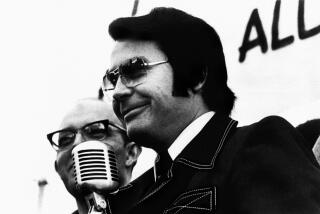For Many, PTL Stands for Truth, Beauty, Not Scandal
- Share via
One person’s guru is another’s charlatan, so it is not surprising that we all stay tuned to the new Jim and Tammy Faye show. Regularly the nightly news brings us yet more information about the audacious, rapacious, avaricious Bakkers. The PTL Club, it seems, stands for pass-the-loot. A lot was passed, much of it ending up suspiciously--to pay for Jim’s hotel bill, for example, or Tammy Faye’s mascara. Those of us never tempted to pass any loot to the PTL Club stand aghast at the gullibility of those who did. Don’t they feel foolish now?
Judging from the number of letters that the Bakkers reportedly continue to receive, one has to assume that at least some PTL supporters remain steadfast. If so, we ask now with even greater incredulity: How can people still be taken in by that stuff? Several answers might be offered.
First, people may believe what they cannot prove. What seems an absurd proposition to you may be a matter of great conviction to me. You would not pay $10 for the off-the-road tricycle that I just bought for a price equal to a month’s salary. Yet you readily concede that I must value something about the transaction, however mistaken you regard my values. Similarly, PTL supporters must find something there of value, even if we cannot.
Virtually all religious organizations spend most of their income on self-maintenance, even if most clergy are not paid outsized salaries. Contributing members of these churches can therefore be assumed to believe that they receive their money’s worth. Televangelists’ audiences probably believe that they do, too, no less than do the members of First Church Anywhere.
But what, in heaven’s name, does the money buy when contributed to the PTL, or any of the other slick television shows parading as “evangelical” Protestant Christianity? In her statement to the press that her followers, she was sure, wanted her to live luxuriously, Tammy Faye offered a second clue as to why people watch such stuff. Sounding much as Imelda Marcos sounded in explaining the thousands of shoes found in her closet, Mrs. Bakker makes hedonism sound positively like self-denial.
Religion generally makes self-indulgence sinful, and religion with roots in Calvinism does so especially. Yet here is an avatar of self-centered consumerism whose clothes and makeup, combined with an ethic of feeling good about oneself, are offered in the name of the Lord. Amazing grace, how sweet thou art! If, as we might assume, a lot of Americans stand ready to indulge once they are given ideological permission, then perhaps something along the lines of a weekly PTL pledge is not too high a price to pay.
A third answer extends beyond the bouffant brigade. Research makes clear that televangelists hold little appeal for the college-educated, none at all for would-be self-indulgent Yuppies. We are thus reminded that what inures the educated professional class to such appeals is a shared elite subculture, but it is a subculture not extending all that far. As George Steiner wrote recently in the New Yorker, “The best evidence is that at least one-third of the adult citizens of the United States are illiterate . . . . Of the remaining two-thirds . . . at least one-half, while technically literate, scarcely read at all, or read only print of the simplest and most ephemeral kind.”
Persons outside the elite subculture do not share a single alternative, competing subculture, however. Rather, they may hold to one or more world views derived from such sources as region, kinfolk, occupation or televangelism. Confirmation of the fundamental meanings that they attach to existence is neither sought nor found in “public,” but in particularistic worlds that are quite unknown to the participants in the elite subculture. We think it strange that others find truth, beauty and a sense of community coming out of an electronic gadget because that sort of thing is unlikely to occur to us. But we also find it strange that some Americans find life’s meaning in sports or in situation comedies.
America’s elite subculture transcends partisan politics, region, ethnicity and religious identification. The communication and educational network serving that subculture is not the only network, however. All kinds of pockets of thought and belief can thus not only exist but also thrive in the anonymity of American social structure. Alternative publishing firms, newspapers, radio stations, collegesand churches pour out their messages but do so largely unnoticed by members of the elite. For example, Hal Lindsay’s “Late Great Planet Earth”--predicting Armageddon soon--was the best-selling nonfiction book in America during the 1970s, yet not a single University of California library has it.
What makes televangelism different is that, especially with satellite technology, the private world of fundamentalist or Pentecostal Protestantism has lost its anonymity. It has become known to those of us who would otherwise pay no attention. Jim and Tammy Faye Bakker thus caught a spotlight that they might have avoided a few years ago.
DR, DANZIGER, The Christian Science Monitor
More to Read
The biggest entertainment stories
Get our big stories about Hollywood, film, television, music, arts, culture and more right in your inbox as soon as they publish.
You may occasionally receive promotional content from the Los Angeles Times.










